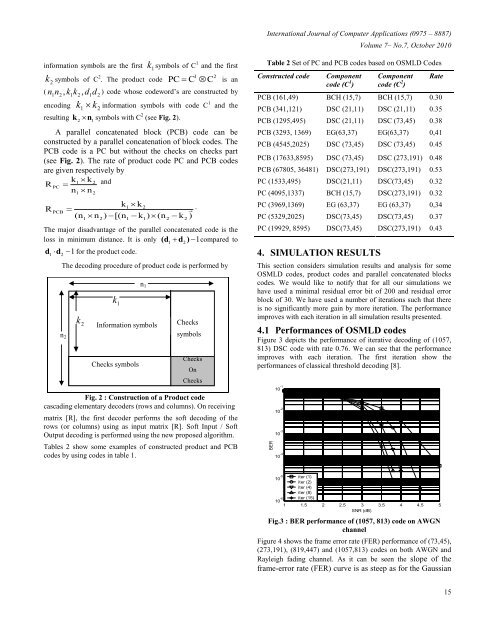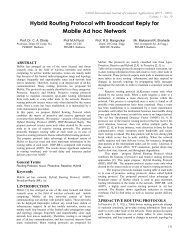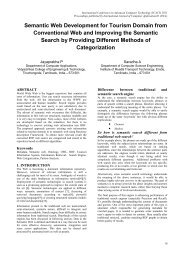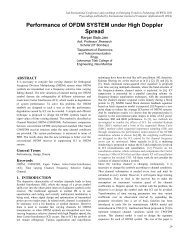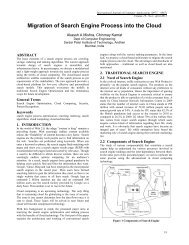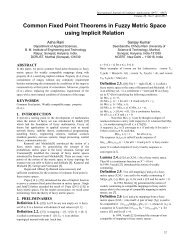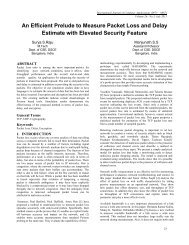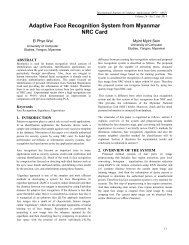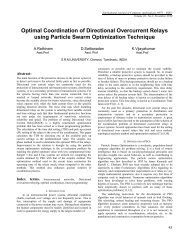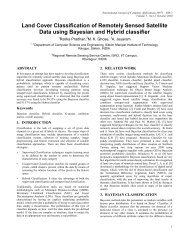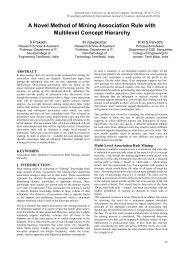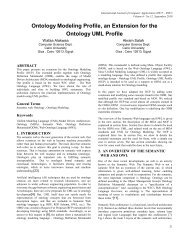IJCA Template - International Journal of Computer Applications - IJCA
IJCA Template - International Journal of Computer Applications - IJCA
IJCA Template - International Journal of Computer Applications - IJCA
Create successful ePaper yourself
Turn your PDF publications into a flip-book with our unique Google optimized e-Paper software.
BER<br />
<strong>International</strong> <strong>Journal</strong> <strong>of</strong> <strong>Computer</strong> <strong>Applications</strong> (0975 – 8887)<br />
Volume 7– No.7, October 2010<br />
information symbols are the first k1<br />
symbols <strong>of</strong> C 1 and the first<br />
k<br />
2 symbols <strong>of</strong> C 2 1 2<br />
. The product code PC C C is an<br />
( n<br />
1<br />
n2, k1k2<br />
, d1d<br />
) code whose codeword’s are constructed by<br />
2<br />
encoding k1 k2<br />
information symbols with code C 1 and the<br />
resulting k2n1symbols with C 2 (see Fig. 2).<br />
A parallel concatenated block (PCB) code can be<br />
constructed by a parallel concatenation <strong>of</strong> block codes. The<br />
PCB code is a PC but without the checks on checks part<br />
(see Fig. 2). The rate <strong>of</strong> product code PC and PCB codes<br />
are given respectively by<br />
k1<br />
k2<br />
R<br />
PC<br />
and<br />
n n<br />
R<br />
PCB<br />
1 2<br />
k1k2<br />
<br />
.<br />
(n n ) [(n k ) (n k )<br />
1 2 1 1 2 2<br />
The major disadvantage <strong>of</strong> the parallel concatenated code is the<br />
loss in minimum distance. It is only (d1d 2)<br />
1compared to<br />
d<br />
1d2 1<br />
for the product code.<br />
The decoding procedure <strong>of</strong> product code is performed by<br />
k<br />
2<br />
k<br />
1<br />
Information symbols<br />
Checks symbols<br />
Checks<br />
symbols<br />
Checks<br />
On<br />
Checks<br />
Table 2 Set <strong>of</strong> PC and PCB codes based on OSMLD Codes<br />
Constructed code<br />
Component<br />
code (C 1 )<br />
Component<br />
code (C 2 )<br />
Rate<br />
PCB (161,49) BCH (15,7) BCH (15,7) 0.30<br />
PCB (341,121) DSC (21,11) DSC (21,11) 0.35<br />
PCB (1295,495) DSC (21,11) DSC (73,45) 0.38<br />
PCB (3293, 1369) EG(63,37) EG(63,37) 0,41<br />
PCB (4545,2025) DSC (73,45) DSC (73,45) 0.45<br />
PCB (17633,8595) DSC (73,45) DSC (273,191) 0.48<br />
PCB (67805, 36481) DSC(273,191) DSC(273,191) 0.53<br />
PC (1533,495) DSC(21,11) DSC(73,45) 0.32<br />
PC (4095,1337) BCH (15,7) DSC(273,191) 0.32<br />
PC (3969,1369) EG (63,37) EG (63,37) 0,34<br />
PC (5329,2025) DSC(73,45) DSC(73,45) 0.37<br />
PC (19929, 8595) DSC(73,45) DSC(273,191) 0.43<br />
4. SIMULATION RESULTS<br />
This section considers simulation results and analysis for some<br />
OSMLD codes, product codes and parallel concatenated blocks<br />
codes. We would like to notify that for all our simulations we<br />
have used a minimal residual error bit <strong>of</strong> 200 and residual error<br />
block <strong>of</strong> 30. We have used a number <strong>of</strong> iterations such that there<br />
is no significantly more gain by more iteration. The performance<br />
improves with each iteration in all simulation results presented.<br />
4.1 Performances <strong>of</strong> OSMLD codes<br />
Figure 3 depicts the performance <strong>of</strong> iterative decoding <strong>of</strong> (1057,<br />
813) DSC code with rate 0.76. We can see that the performance<br />
improves with each iteration. The first iteration show the<br />
performances <strong>of</strong> classical threshold decoding [8].<br />
n 2<br />
n 1<br />
1 1.5 2 2.5 3 3.5 4 4.5 5<br />
10 -1 SNR (dB)<br />
Fig. 2 : Construction <strong>of</strong> a Product code<br />
cascading elementary decoders (rows and columns). On receiving<br />
matrix [R], the first decoder performs the s<strong>of</strong>t decoding <strong>of</strong> the<br />
rows (or columns) using as input matrix [R]. S<strong>of</strong>t Input / S<strong>of</strong>t<br />
Output decoding is performed using the new proposed algorithm.<br />
Tables 2 show some examples <strong>of</strong> constructed product and PCB<br />
codes by using codes in table 1.<br />
10 -2<br />
10 -3<br />
10 -4<br />
10 -5<br />
10 -6<br />
iter (1)<br />
iter (2)<br />
iter (4)<br />
iter (8)<br />
iter (15)<br />
Fig.3 : BER performance <strong>of</strong> (1057, 813) code on AWGN<br />
channel<br />
Figure 4 shows the frame error rate (FER) performance <strong>of</strong> (73,45),<br />
(273,191), (819,447) and (1057,813) codes on both AWGN and<br />
Rayleigh fading channel. As it can be seen the slope <strong>of</strong> the<br />
frame-error rate (FER) curve is as steep as for the Gaussian<br />
15


